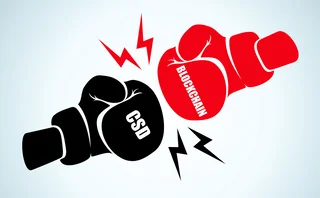
Extending to Asia
Continuous-linked settlement – the initiative designed eliminate forex settlement risk – went live at the end of last year. But with only Australia and Japan represented in the first batch of currencies, what will CLS mean for Asia’s banks? Roger Hogan reports

So far, so good. Continuous-linked settlement (CLS) – the global initiative designed to reduce if not eliminate cross-border settlement risk, initially in the foreign exchange markets – went live with 39 of its shareholder banks last September and has been humming along nicely since.
In November, the initiative was widened to include non-shareholder banks and third-party customers of member banks. The focus now is on extending the system throughout the global banking fraternity, including banks in Asia. And this is where it gets interesting, for a number of reasons. First, the Asian time-zone sits awkwardly with the fact that CLS transactions are settled during central European time. This means that, for banks in Asia, a lot of CLS settlement activity becomes compressed into the end of the local working day. Australia and Japan, the only Asian countries whose currencies are already eligible for CLS settlement, have had to adjust accordingly.
“It’s a 24-hour system, and our day opens at about 7:30 in the morning and we keep going, during daylight saving hours, to 9:30 at night. It’s extended our working day, obviously,” says Sachin Maharaj, head of treasury services at HSBC in Sydney. Such are the wonders of time zones, state-of-the-art communications and globalisation, the Sydney office covers the morning shift of HSBC’s CLS operation in London.
At HSBC and other CLS banking operations located in Australia, the change in working practices has been felt beyond the foreign exchange desk. “We’re running two double shifts, and so the [Reserve Bank of Australia] payments system has been extended by those hours,” says Maharaj. “It means that you can do not only CLS transactions but also any other transactions. It used to be that all banks were forced to square away before they went home at 4:30 or 5pm. Now, if they wanted to, they can still do transactions and intra-day repos with the RBA up to 8 or 9pm.”
Longer hours and double shifts have also meant having to put on more people, although Maharaj says the cost of doing so for HSBC has been fairly minimal, requiring only one additional dealer and two operational staff.
Another limiting factor for many Asian banks thinking of joining CLS – at least those thinking of doing so directly – is the fact that, as in the forex markets generally, the name of the game in CLS is volume.
“For a number of the institutions in Asia, with the exception of the top banks in each individual country, their volumes will not be as high as, say, those of their counterparts in Europe and America,” says Mark Heaton, a senior vice-president and sector head in HSBC’s institutional banking relationship business in Hong Kong. “In each country you will have the top two or three who are pretty large players, then you’ll have the next batch and a smaller batch, and I suppose the challenge for them is to decide what are the costs against the benefits of joining CLS.”
There are also factors of a more structural nature governing how, when and on what terms Asian banks will accede to the system. Arguably the most important of these is the design of the CLS roll-out programme, while another concerns the credit perceptions attached to individual Asian economies. To understand the CLS roll-out design, it helps to recall how and why the system came into existence in the first place.Its genesis lies in the 1974 collapse of Germany’s Bankhaus Herstatt, where a number of counterparties had paid large amounts of Deutschmarks to the bank but had not yet received dollars in exchange, as the US financial markets had just opened for the day.
In essence, Herstatt risk was twofold: it lay not only in the fact that each side of a forex trade was paid separately, but also that such trades were run across different time zones, exacerbating the risk of a counterparty’s exposure to default already inherent in the two-stage trade structure.
The London-based CLS Bank International was set up in the mid-1990s by an initial group of 20 shareholder banks to develop a system that would obviate Herstatt risk, as far as possible. After CLS went live in September, the bank had 69 shareholders and the number is still growing. Under CLS, each side of a trade can now be settled simultaneously and irrevocably on a ‘payment versus payment’ basis.
CLS Bank stands at the top of the system hierarchy. Immediate below are the settlement members, all of which are CLS Bank shareholders. They have multi-currency accounts with CLS Bank, and input deals directly on their own behalf or on behalf of their customers.
Next in line come the user members. These can submit settlement instructions for themselves and their customers. They do not have accounts with CLS Bank, however, and must be sponsored by a settlement member, which acts on the user member’s behalf. Finally come the third-party members, which are customers of settlement and user members and have no direct access to CLS: all their instructions and financial flows must be handled by settlement or user members and consolidated within CLS. The terms and conditions of all such arrangements are private.
The shareholder banks, for obvious reasons, are drawn from the upper leagues of the industry in the US, Europe and Asia-Pacific. The upfront cost for each bank to participate in CLS at the outset was $5 million, and this figure is thought to have risen considerably during the project’s development, which lasted four years because of delays in the delivery of the necessary technology. According to CLS Bank, its shareholders account for more than half the value transferred in the forex market, with five of them alone accounting for 44% of turnover.
Similarly, the seven currencies so far admitted for settlement – Australian, Canadian and US dollars, euro, sterling, yen and Swiss franc – were chosen on the basis of their robustness and market share. Three Asian currencies – the Singapore, Hong Kong and New Zealand dollars – are likely to be admitted in the next year or so, as are the Swedish krona, Danish krone and Norwegian krone.
From an institutional perspective, currency eligibility and the role of Asian central banks in steering their respective countries towards CLS membership will be critical, particularly from the point of view of helping to build a business case in favour of membership.
“The biggest issue, of course, is that in all countries the regulators are very keen to explore ways of reducing risk in the market,” says HSBC’s Heaton. “CLS is clearly a very major initiative in this respect, and the main driver behind many of those institutions will be not only how much the central bank or regulator has pushed them, but also whether their currency will be involved in CLS. Clearly at the moment there are not many Asian currencies in CLS. Singapore is going live [in May] and discussions are taking place with regard to the Hong Kong dollar, South Korean won and the New Zealand dollar, but that will be next year.” A significant number of forex transactions for banks in these Asian countries are local currency against the US dollar, euro or sterling, so once these local currencies are included, there will be massive benefits for these banks to use CLS, Heaton continues.
The structural issues linked to the pros and cons of Asian banks’ CLS membership revolve around liquidity. One of the criticisms of CLS is that, while it reduces settlement risk, it intensifies the need for liquidity within quite narrow trading windows and, arguably, increases liquidity risk in the settlement system. This is of particular concern in Asia, where intra-day liquidity generally lacks depth and dependability.
“The liquidity markets, if they exist at all, tend to be somewhat temperamental and unreliable in terms of the fact that CLS has a very definitive time schedule,” says Stephen Street, clearing product manager at JP Morgan Chase in Singapore. “You need to have liquidity pretty much immediately - it’s not a matter of getting liquidity in an hour’s time, you need to get it at that moment – and that situation, frankly, doesn’t exist presently.”
Another structural issue relates to counterparty credit risk. However, a number of Asian countries are addressing both of these points. India, for example, is looking at possible solutions, including a form of credit-enhanced structure, to enable its credit-challenged institutions to participate in CLS. And banks from several countries are investigating the potential for a cross-currency collateral pool – in which an institution could use its local currency debt to trade in a foreign currency – to ease the constraints on intra-day liquidity.
One of the most striking examples to date of a local initiative to facilitate Asian banks’ participation in the system is Clearing & Payment Services (Caps), a joint-venture utility owned equally by Singapore’s DBS Bank, OCBC Bank and UOB. The company, formed early last year, provides a shared infrastructure through which each bank can effect its individual CLS needs (and those of its clients) while pooling, and thereby significantly reducing, its capital costs. All three banks are settlement members of CLS.
“Caps is a first-of-its-kind CLS utility model that aggregates CLS transactions and provides value-added services for its bank customers,” says Bill Chua, chairman of Caps and executive vice-president, operations sector, at UOB in Singapore. “Most CLS member banks have traditionally built direct connections to CLS, but the three Caps members have developed a truly creative and innovative means of connection to CLS. This infrastructure can be leveraged effectively by other banks, resulting in scale economies for all participants.” Caps was designed to be a multi-entity processing utility and, adds Chua, has the distinction of being the first “financial services universal processing centre” in Singapore.
Singapore and forex trades are just the beginning, however. The plan is to extend the service to other participants and other product lines within CLS. “We are currently in discussions with various banks in Asia and other regions,” says Chua. “Each of these banks is at a different stage of their evaluation for participation in CLS. We believe that Caps would offer them the most cost-effective option due to economies of scale by sharing our infrastructure, as our operations are already compliant to CLS’ stringent requirements. Over time, we will be targeting other banks that are already operational on CLS as an outsourcing option as they get into their next investment cycle in CLS systems.”
Settlement members of US and European origin, meanwhile, are competing in a traditional, individualistic way to offer CLS services to their clients around the region, focusing mainly on third-parties, which represent a bigger universe of opportunities than user members. Citibank, Deutsche Bank, HSBC and JP Morgan Chase lead the pack, followed by ABN Amro and Standard Chartered. Citibank recently announced that it had signed up Union Bank of Taiwan as a third-party customers; JP Morgan Chase admits to having Daiwa Bank on its books and hints at two others, while HSBC claims to have recruited one Asian third party, which it declines to name.
“We’re confident that CLS will become the primary method to settle forex transactions in the future. Pick-up in Asia is gaining momentum,” says Chua. “Asian banks will not be able to ignore the benefits of CLS with the inclusion of third parties, and the introduction of new CLS currencies once CLS volumes reach a critical mass.”
Only users who have a paid subscription or are part of a corporate subscription are able to print or copy content.
To access these options, along with all other subscription benefits, please contact info@risk.net or view our subscription options here: http://subscriptions.risk.net/subscribe
You are currently unable to print this content. Please contact info@risk.net to find out more.
You are currently unable to copy this content. Please contact info@risk.net to find out more.
Copyright Infopro Digital Limited. All rights reserved.
As outlined in our terms and conditions, https://www.infopro-digital.com/terms-and-conditions/subscriptions/ (point 2.4), printing is limited to a single copy.
If you would like to purchase additional rights please email info@risk.net
Copyright Infopro Digital Limited. All rights reserved.
You may share this content using our article tools. As outlined in our terms and conditions, https://www.infopro-digital.com/terms-and-conditions/subscriptions/ (clause 2.4), an Authorised User may only make one copy of the materials for their own personal use. You must also comply with the restrictions in clause 2.5.
If you would like to purchase additional rights please email info@risk.net
More on Settlement risk
Margin settlement risk and its effect on CVA
Sponsored feature: CompatibL
CLS to replace core settlement system
Overhaul will leverage conventional technology rather than blockchain solution that underpins new CLSNet service
Netting no problem for blockchain, tech firms tell regulators
Firms say DLT can sit with current market practice, but instantaneous settlement 'not desirable'
Distributed ledger innovators imagine a world without CSDs
CSDs counter they fulfil functions blockchain cannot, and regulatory changes are needed to disintermediate them
Banks eye Traiana for EM forex netting service
Industry turns to utility as CLS emerging markets push stalls
Euroclear and Clearstream granted time to agree joint road map
Icma ERC continues to push for plans to improve Bridge settlement times
CLS facing obstacles adding RMB to its platform
RMB volumes set for growth but settlement remains an issue
FX clearing a priority for 2014, vows CLS chief
Working with banks and CCPs to facilitate central clearing of OTC forex options is 'high priority strategic initiative' for CLS this year, says chief executive David Puth







